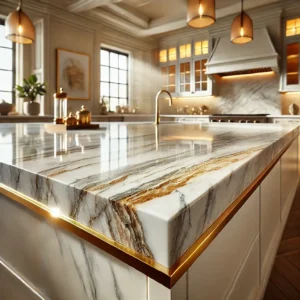How to Remove Stains from Stone Countertops
Knowing how to remove stains from stone countertops is essential for maintaining their beauty and durability. Whether you have quartzite, quartz, or granite, spills and everyday use can cause unwanted marks. Fortunately, with the right cleaning techniques, you can keep your countertops looking like new.
💡 Looking for a complete countertop guide? Check out our post on Types of Countertops: Discover the Best Materials for Your Home.
This guide will show you how to remove stains from stone countertops and prevent future damage.
Understanding Different Stone Countertops
Before choosing a cleaning method, it’s important to know how different stone surfaces react to stains:
- Quartzite – A natural stone that is porous, meaning it can absorb spills if not sealed properly.
- Quartz – A non-porous engineered stone that resists most stains but can be affected by harsh chemicals.
- Granite – A durable natural stone that resists stains when sealed but can absorb liquids if left unprotected.
Since each material behaves differently, using the wrong cleaning method can cause damage instead of removing the stain.
How to Remove Stains from Stone Countertops
1. Removing Stains from Quartzite
Water Rings & Hard Water Stains:
- Mix baking soda and water to form a paste.
- Apply to the stained area and let it sit for 10 minutes.
- Wipe with a damp microfiber cloth.
Oil & Grease Stains:
- Sprinkle baking soda or cornstarch on the stain.
- Let it absorb the oil for 15 minutes, then wipe clean.
- Use mild dish soap and warm water if needed.
Wine & Coffee Stains:
- Combine hydrogen peroxide and baking soda into a paste.
- Apply and let sit for 30 minutes, then rinse.
Avoid using vinegar or acidic cleaners on quartzite, as they can etch the surface.
2. Removing Stains from Quartz
Coffee & Tea Stains:
- Mix mild dish soap with warm water and wipe the surface.
- Use glass cleaner or rubbing alcohol if the stain remains.
Food Dye & Juice Stains:
- Apply baking soda and water paste to the stain.
- Let it sit for 10 minutes, then rinse.
Ink & Marker Stains:
- Dab rubbing alcohol on a cloth and gently rub the stain.
- Rinse with water and dry with a clean towel.
Never use abrasive pads or harsh chemicals like bleach, as they can damage quartz.
3. Removing Stains from Granite
Oil-Based Stains:
- Apply a baking soda and water paste to the stain.
- Cover with plastic wrap and let sit for 24 hours.
- Wipe away and rinse with warm water.
Organic Stains (Wine, Coffee, Food Spills):
- Mix hydrogen peroxide and dish soap.
- Apply with a cloth and gently rub.
Rust & Metal Stains:
- Use a pH-neutral stone cleaner and a soft brush.
- If needed, apply a baking soda paste and let sit for 15 minutes before rinsing.
Avoid acidic cleaners like lemon or vinegar, as they can dull granite’s finish.
Preventing Stains on Stone Countertops
Seal natural stone countertops regularly to prevent absorption.
Wipe spills immediately before they soak into the surface.
Use cutting boards and coasters to avoid direct contact with food and drinks.
Clean with pH-neutral stone cleaners to maintain the finish.
With proper care, your countertops will stay stain-free and beautiful for years to come!
Final Thoughts
Stains on stone countertops can be frustrating, but using the right cleaning methods can restore your surfaces to their original beauty. Whether you’re dealing with oil stains, coffee spills, or water rings, a little effort goes a long way in keeping your countertops looking flawless.
💡 Want to learn more about countertop care? Read our guide on Types of Countertops: Discover the Best Materials for Your Home.
Need expert cleaning advice? Fill out our quote request form for personalized recommendations!
Your Thoughts?
Struggling with a tough stain? Fill out our quote request form to get customized cleaning advice! 🚀





